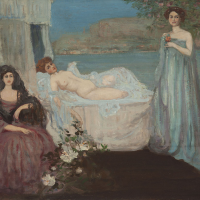35. CHARLES CONDER

Charles Conder was an extraordinary figure in Australian art: precocious, gifted, and outrageously successful. He is now fully acknowledged as a major figure in Australias cultural heritage his works are passionately collected (Barry Humphries has the worlds largest collection) and in 1991 Canberra even named a suburb after him.
Conder was right there in the midst of the group that developed Australian Impressionism Tom Roberts (1856-1932), Arthur Streeton (1867-1943), Frederick McCubbin (1855-1917) and Charles Richardson (1853-1932) all claimed him as a close friend. He exhibited with them in the historic 9 x 5 Impressions show at Buxton Galleries, in Melbournes Swanston Street, on 17 August 1889. He also shared a studio with Tom Roberts and went on to exhibit at the citys Victorian Artists Society in Albert Street, before leaving for London and Paris in 1890.
Fame came quickly to Conder: his natural talent ensured that he was swiftly accepted into an artistic circle that included Aubrey Beardsley (1872-1878), Augustus John (1878-1961), Walter Sickert (1860-1942) and Oscar Wilde (1984-1900). Furthermore, he is the only Australian artist to be depicted by the famous Toulouse Lautrec (there are eight in existence) and the first to become eminently well known and widely collected in both London and Paris. Remarkably, his first retrospective exhibition (1927) was mounted by Londons prestigious National Gallery.
However, for a long time Conder remained largely unknown in Australia. That is, until the publication of John Rothensteins monograph (The Life and Death of Conder) in 1938, almost thirty years after the artists untimely death from paresis at Virginia Water in Surrey. Rothenstein, a close friend of T.E. Lawrence ('Lawrence of Arabia') and the Bloomsbury Group artists, went on to become the Director of The Tate Gallery for a record term (1938-1964).
Lamentably, it was not until the Sixties that Australia reclaimed Conder. This turnaround came after Dr. Ursula Hoffs scholarly publication in 1960. This revision of Condors status was confirmed by a major retrospective exhibition at Melbournes National Gallery of Victoria in 1966 and firmly cemented by Hoffs later publication in 1972. The breakthrough represented by these two publications was given further expert credence in two later comprehensive publications: Sarah Wheatleys Charles Conder 1868-1909 of 1989 and Ann Galballys Charles Conder: The Last Bohemian of 2002.
Conders Rve Diurne (Day Dream), of circa 1904, is highly characteristic of the artists move into adopting the style of late-Symbolism and Aestheticism in England. These movements tended to emphasise sensibility and mood in ways
that highlighted visual enjoyment rather than political or social content.
In his oil paintings such as Rve Diurne (Day Dream) the semi-transparent techniques of his silk paintings (after the inspiration of Watteau) are used to depict imagined scenes in idyllic locations. These invariably show groups of figures in mythological or literary settings, usually with dreamy afternoon, early evening or moonlit atmospheres.
The present painting depicts just such a setting: a parable-like or fairy-tale grouping of three female figures, in three different poses, between a beach cabana and a seated servant-like figure. The lake or ocean-side landscape is suggested rather than defined. The atmosphere is translucent, as though glimpsed through the screen of time, which lends to the painting the dreamy atmosphere so desired as a foil to the sparseness of some Victorian interiors and the severity of Georgian architecture.
It is more than likely that Conder has deliberately depicted three nationalities of women: English on the right, Italian in the centre and Spanish on the left and that the painting has an obscure literary or personal source. Whatever the case, the present painting shows him at his most popular peak and has very strong stylistic affinities with his Ferring Grange in the Leeds Museum, Figures on a Beach in the British Government collection, On the Beach, Swanage in the Sheffield City Art Gallery and The Ord of Caithness, Highlands in the Aberdeen Art Gallery.
Associate Professor Ken Wach
Dip. Art; T.T.T.C.; Fellowship RMIT; MA; PhD
Emeritus Principal Research Fellow and Head,
School of Creative Arts
The University of Melbourne